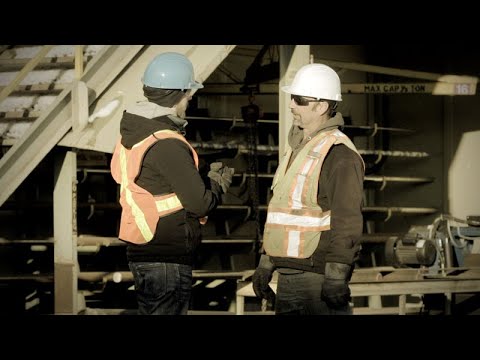Career Overview
Labourers in wood, pulp and paper processing carry out a variety of general labouring and routine wood processing activities. They also help pulp mill and papermaking machine operators.
They work for pulp and paper converting companies, sawmills, planing mills, wood treatment plants, waferboard plants and other wood processing companies.
Job Titles
Duties
Labourers in wood, pulp and paper processing perform some or all of the following duties:
- Feed logs onto conveyor and into hopper of grinding machine and align logs manually, using crowbar, picaroon or other tools and equipment
- Load wood chips, pulpwood, sulphur and other processing materials onto conveyors or processing tanks, remove recyclable paper and pulp from pulp and papermaking machines and transport recyclable paper and pulp to plant processing machines and equipment using forklift or other powered equipment
- Sort, pile and transport lumber, veneer sheets, panelboards and similar wood products during various stages of wood processing, manually or with powered equipment
- Remove scrap lumber and wood chips for reprocessing using forklift or other powered equipment
- Feed conveyors, saws, drying machines and other equipment to process lumber, shingles, veneer, plywood and similar wood products
- Clean wood processing machines and equipment and work areas using shovels, hoses and other tools
- Help other wood processing workers to operate, maintain and repair various machines and equipment and carry out other wood processing activities
Earnings
Earnings is income that workers receive in exchange for their labour. Depending on the type of employment, earnings can be in the form of wages (hourly), salaries (fixed monthly or annual) or self-employed earnings.
Work Environment
# Workers Employed
4,770% Employed Full Time
56%Key aspects of the work in this occupational group:
- These labourers generally work in an indoor plant environment near or with equipment, instruments, machinery or power/hand tools that may be a potential source of accident or injury
- Workers may be exposed to flying particles, noise, vibration, strong odours and dust
Career Pathways
There is considerable mobility among jobs within individual establishments.
Progression to machine or plant operating positions is possible with experience.
Related Careers
Occupational Interests
It’s important to understand what kinds of occupations align with your interests.
For more about occupational interests visit Skills for the Future Workforce > Characteristics.
Here are the top occupational interest(s) for this career profile:
Education, Training and Skills
- Completion of secondary school is required by the pulp and paper industry and by other large employers
Education programs in B.C.
The following program areas are related to this occupation:
- Academic/Basic Upgrading

Skills
Every job calls for a certain set of skills. Knowing those skills is the first step in finding a good career fit.
Here, you will find the 10 most relevant workplace skills. Some are more important to achieving success in a certain career than others. These skills may come naturally to you or you may need to gain them through education, training and experience.
See the list of work-related skills below, ranked in order of importance for this career. Check out the list and see if this career matches your skills—take that first step!
Watching gauges, dials or other indicators to make sure that a machine is working properly.
Keeping track of and assessing your performance, other individuals, or organizations to make improvements or take corrective action.
Giving full attention to what other people are saying, taking time to understand the points being made, asking questions as appropriate, and not interrupting at inappropriate times.
Talking to others to share information effectively.
Understanding written sentences and paragraphs in work-related documents.
Conducting tests and inspections of products, services or processes to evaluate quality or performance.
Using logic and reasoning to identify the strengths and weaknesses of alternative solutions, conclusions or approaches to problems.
Controlling operations of equipment or systems.
Adjusting actions in relation to others' actions.
Being aware of others’ reactions and understanding why they react as they do.
Labour Market Statistics
Discover data, facts and information that have been gathered and analyzed. Learn about the characteristics of the economy and labour market in B.C.
Employment
Find out about employment types and trends by region and industry.
Employment
4,770Employment by Region







| Region | Employment | % Employment of this Occupation |
|---|---|---|
| Cariboo | 1,025 | 21.5% |
| Kootenay | 330 | 6.9% |
| Mainland/Southwest | 1,395 | 29.2% |
| North Coast and Nechako | 480 | 10.1% |
| Northeast | 165 | 3.5% |
| Thompson-Okanagan | 990 | 20.7% |
| Vancouver Island/Coast | 395 | 8.3% |
Labour Market Outlook
The B.C. Labour Market Outlook is a 10-year forecast of the expected supply and demand for labour in the province. It’s usually updated every year. The purpose is to provide British Columbians with the knowledge to make informed decisions on careers, skills training, education and hiring.
Forecasted Job Openings (2024-2034)
920Forecasted Job Openings
Forecasted Employment Growth Rate
Composition of Job Openings
Job Openings by Region (2024-2034)







| Region | Job Openings | Avg. Annual Employment Growth |
|---|---|---|
| Cariboo | 180 | -0.3% |
| Kootenay | 60 | -0.8% |
| Mainland/Southwest | 320 | -0.3% |
| North Coast and Nechako | 80 | 0.5% |
| Northeast | 20 | -0.6% |
| Thompson-Okanagan | 190 | -1.1% |
| Vancouver Island/Coast | 70 | -0.5% |
Industry Highlights
Learn about the opportunities in B.C.'s major industries, including employment trends, earning potential, locations of work and more.
Forecasted Job Openings by Industry
| Industry | Job Openings (2024-2034) |
|---|---|
| Manufacturing | 680 |
| Wholesale Trade | 50 |
| Retail Trade | 30 |
| Construction | 30 |
| Transportation and Warehousing | 30 |
Resources
Resource information is currently not available.









